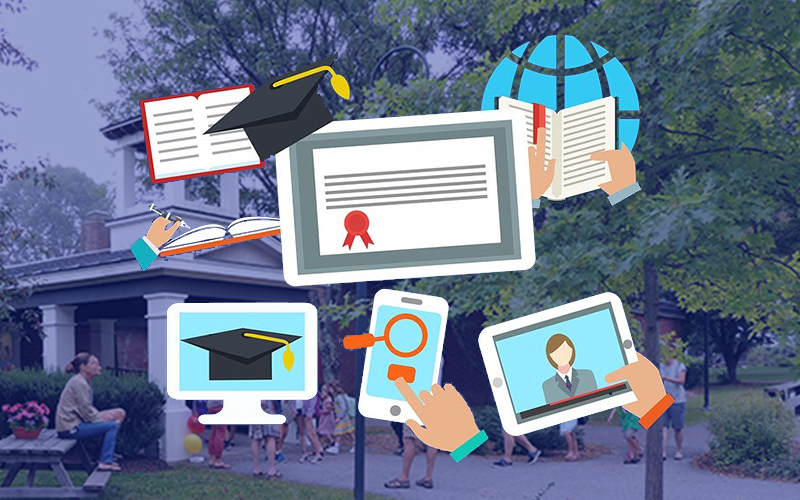The technology is advanced. As students in the Harwood Unified Union School District (HUUSD) transition to remote learning, they have a variety of online tools at their disposal. Zoom lets students video chat with classmates and teachers together. Google Classroom lets students check and turn in assignments, watch instructional videos and get feedback. Seesaw allows students to create a digital portfolio of their work to share with classmates, teachers and parents.
Long before HUUSD schools closed due to the COVID-19 pandemic, educators like seventh-grade English teacher John Potts had already been using these online apps for school assignments. “All of this has been digital anyway,” said Potts. “It was helpful for us that we already had this skillset because creating the remote curriculum was actually very similar to what we already have been doing. That part was not hard.”
Potts was pleased with the way the school administration directed the transition to online learning. Students were given two days off while teachers met in the high school to create a remote learning plan. “Everybody was relieved at the way we did it. They weren’t trying to continue to develop this concept while also teaching at school. That would’ve been really stressful. Having two days in the building to develop this together was really good. The energy was supportive. Most of the people around me were appreciative of how the administration handled it,” said Potts.
TEACHERS WORRIED
As remote learning kicked off last week, some teachers were worried that students would abandon school without the pressure of being physically present in class. However, Potts said that lack of participation has not been a problem so far. “That’s a fear that most of us are getting over now, the fear that everybody’s just going to go away and not participate. I see students coming into this with a lot of intention. That has been my favorite thing so far,” said Potts.
Moreover, intentional participation in remote learning is not just a phenomenon among the nerdy kids. “The thing that is noticeable about this whole process is that even when you have students that don’t love schoolwork, school is still really important to them and they do show up,” said Potts. When his English class had its first “Google hangout” (aka classwide video chat) Potts said he was nervous that students weren’t going to show up. “But a lot of them came and stayed for the whole time, then came back to the next one later. They just wanted to be there.”
While avid participation of students has made this transition learning easier, there are still holes in the system that educators and administrators are scrambling to fill.
For instance, when Potts saw how many students jumped at the opportunity to participate in a Google hangout, he realized what remote learning was missing: the cultivation of social-emotional relationships. “So many students were so curious about the hangout right away. A lot of them wanted to make sure they didn’t miss it. That just clued me in that this was going to have to be a priority,” said Potts, referring to the class video chat sessions.
This kind of socially motivated class engagement applies to students’ relationships with teachers as well. “When most people think about school, they think about the curriculum and the content. But, really, the part of our day that actually takes priority over the curriculum, even in a normal school day, is the social-emotional part of learning,” said Potts. “This is true especially for students at that middle level. They’re motivated by social connections, not just by grades.”
ADJUST TO TECHNOLOGY
In addition to addressing the social-emotional void caused by remote learning, teachers are trying to adjust to technology-based challenges as well. “The first time I did a three-minute video, it took me three hours,” said Potts.
With remote learning, technical difficulties can occur on the student side of things as well. For instance, during a class hangout students tune in via video chat. In the Zoom app, its easy to get 15 students video chatting at once. But some students don’t have access to laptops with cameras or their internet connection makes it hard for them to hear and be heard. “Every student’s connection is different,” said Potts.
At Harwood Union Middle School, student participation is currently around 85 percent. Why some students aren’t participating is unknown. “We are really trying to figure out who is having the most trouble with [internet access] and how we can work with them. Across the team, we figured out that we have technology communication with the high 40s out of mid 50s number of students. Now we are working on getting the others,” said Potts.
Working from home is another challenge for teachers, especially for those with their own school-age children to care for. Potts and wife, Rachael Potts, who also works at Harwood, have two kids: a second-grade son and a fifth-grade daughter. “We schedule our days by the half-hour. We’re usually about an hour behind schedule. It’s just a lot. I hope that eventually we’ll get a smooth routine that won’t make it feel so stressful. We’re being very intentional about how we use our time. It goes all day. From the morning right into the evening, I’m working and communicating about school. It’s a lot to balance,” said Potts.
As a parent, Potts urges other parents not to stress too much about their own children’s schoolwork during this remote learning period. “If you can’t pull all this off, don’t worry. It’s OK.”






